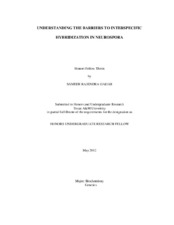| dc.description.abstract | Crosses between two species of Neurospora are typically sterile and result in the
production of non-viable or few viable ascospores. It is unclear what prevents successful
sexual reproduction and the viability of hybrid progeny, given that most species of
Neurospora share high levels of genetic and phenotypic similarity. It has been
hypothesized that genome defense and integrity checkpoints play a critical role in
preventing successful crosses between two different species. In particular, we
hypothesized that either meiotic silencing, DNA methylation, and/or DNA mismatch
repair, or a combination of the above might pose a barrier to interspecific reproduction.
To test this hypothesis, we have selected the species Neurospora crassa and Neurospora
tetrasperma. We used loss-of-function mutations or deletions in key genes for meiotic
silencing, DNA methylation, and/or DNA mismatch repair in Neurospora crassa strains
and, using spore quantification assays, examined the effect of such mutations in crosses
with Neurospora tetrasperma. A significant increase in ascospore production was only
shown in crosses containing a deletion of the Sad-1 gene in the N. crassa strain. In
iv
contrast, no increase in ascospore production was observed by either deletion or
mutagenesis of the Sms-4 gene. Progeny obtained from crosses containing the deletion in
Sad-1 were germinated and analyzed based on genetic and phenotypic characteristic.
Most of the progeny were classified as hybrid and inherited Linkage Group I containing
the deletion of Sad-1 from N. crassa. Our results suggest that meiotic silencing does not
have a significant contribution to reproductive isolation; rather Sad-1 contributes directly
to reproductive isolation at the meiotic stage. | en |


